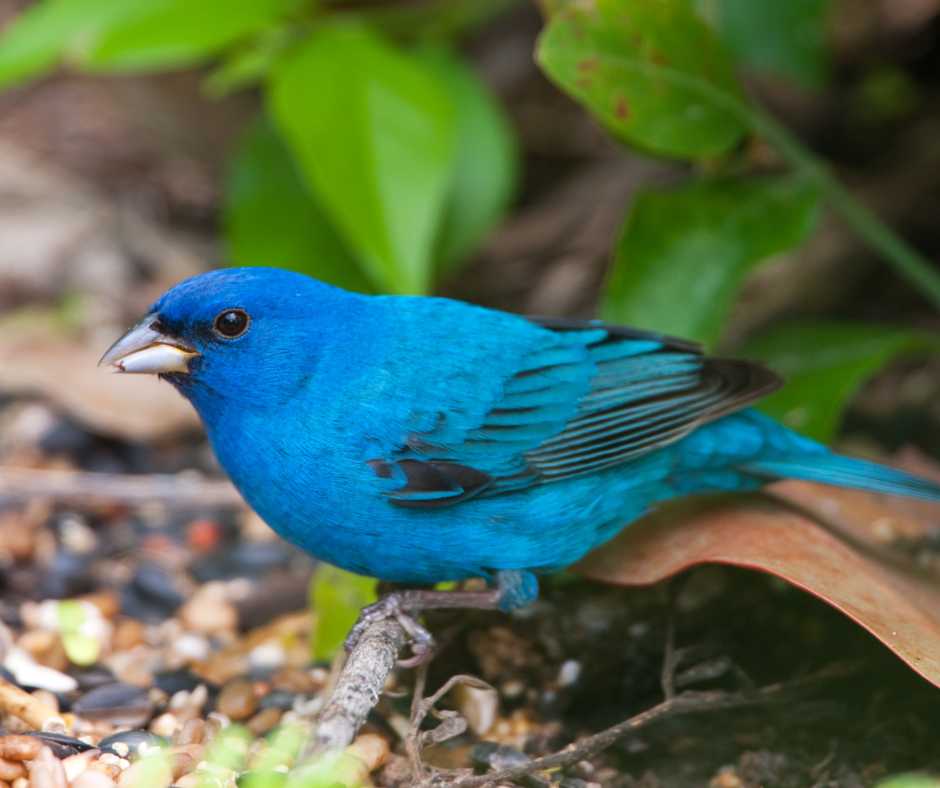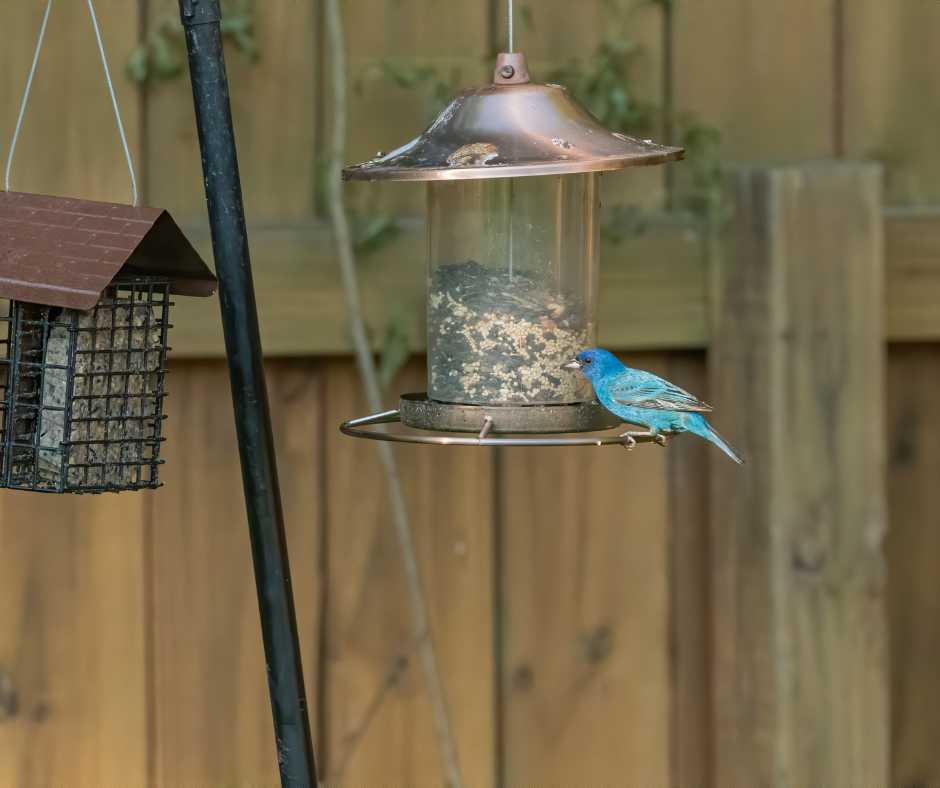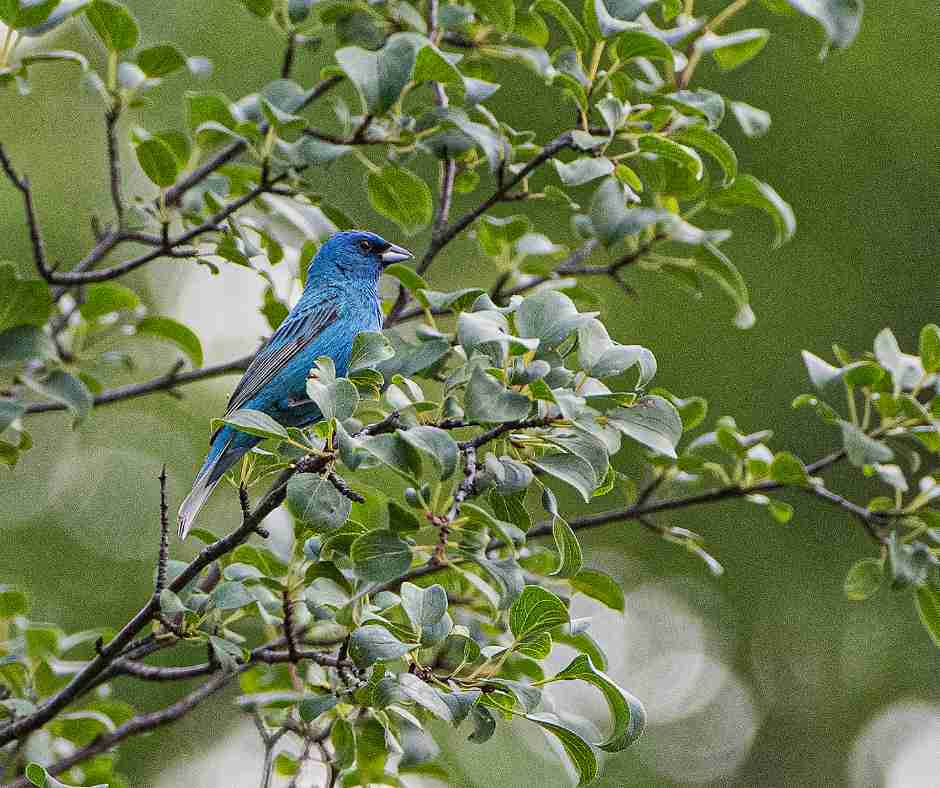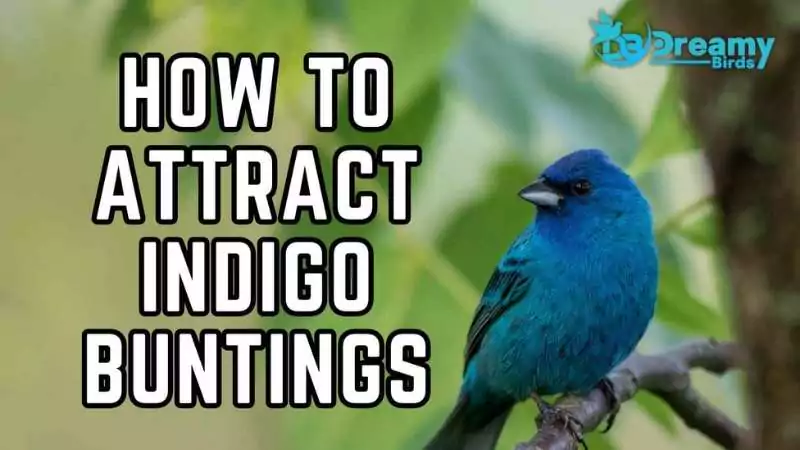Have you ever marveled at the brilliant blue hues of Indigo Buntings? Fun fact: only males flaunt this during breeding! Now, imagine turning your backyard into their VIP retreat. But here’s the catch: they’re all about natural vibes. Explore how to attract Indigo Buntings effortlessly.
Attract Indigo Buntings with diverse feeders, strategic placement, and a bunting-friendly habitat. Supplement their diet with insects, berries, and mealworms. Provide a shallow birdbath, minimize disturbances, and transform your garden into a colorful retreat!
Encounter the challenge: creating a bunting-friendly habitat. Ready for the magic? Learn about feeders, seeds, native plants, and even insects. Make your garden their haven. Ready, set, transform!
Understanding Indigo Buntings
Have you ever wondered about those eye-catching blue birds, the Indigo Buntings? Let’s get to know them better! These tiny birds are famous for their striking blue color. Here’s the cool part: only the males flaunt this brilliant blue during the breeding season; otherwise, they’re more of a brownish color. And the females? They stick to a modest brown year-round.
Indigo Buntings love to hang out where the forest meets the field. It’s like their favorite crossroads between two worlds. They’re not just stay-at-home birds, though. Come winter, they pack their bags and head south – from southern Florida to South America. That’s quite the trip!
During summer, you’ll find them back in the eastern parts of the U.S., adding a splash of color to the landscape.
Curious about more? The Cornell Lab of Ornithology has some fantastic info on these little guys. It’s fascinating how they navigate using the stars at night during their migration. Imagine traveling thousands of miles just by starlight! Now, that’s impressive, right? So, next time you spot one of these blue beauties, you’ll know there’s much more to them than just their good looks!
For more information visit this great resource: Lab of Ornithology at Cornell – All About Birds – Indigo Bunting

4 Tips to Attract Indigo Buntings
Get Indigo Buntings in your garden with four easy steps:
- Use good bird feeders with different seeds and put them in intelligent spots.
- Make a cozy place by planting bushes and native plants and leaving a wild corner.
- Add insects, berries, and mealworms to their food for a tasty menu.
- Make water accessible with birdbaths, creating a happy home for these colorful birds in your garden.
So, let’s move on more in detail.
Optimal Feeder Setup
Want to turn your backyard into a bunting paradise? It’s all about suitable feeders and seeds. Let’s explore the best ways to set up bird feeders to attract those stunning Indigo Buntings.
First up, let’s talk about feeders. There are a few types you should consider. Platform feeders are like open buffets – easy access for buntings. Hanging tube feeders? They’re like the high-rise diners of the bird world, perfect for keeping seeds dry. Ground tray feeders are also a hit, especially for those ground-feeding buddies.
Now, onto the main course: the seeds. White proso millet is like candy for these birds. Nyjer? Oh, they love these tiny, oil-rich seeds. Sunflower chips are also a hit – think of them as the bird equivalent of potato chips! And let’s not forget bark butter – it’s like a special treat for them.
But where do you put these feeders? Placement is key. Keep them away from those sneaky cats – high enough so they’re out of jumping range. Also, place them near some shelter, like bushes or trees, so your feathered friends can make a quick getaway if needed. And, of course, position them where you can enjoy the view – birdwatching should also be a treat for you!
With these tips, your backyard will become a top spot for buntings to hang out. Just imagine sipping your coffee while watching these blue beauties – sounds perfect, right?

Creating a Natural Habitat
Imagine turning your garden into a special place where birds feel cozy and safe, like they have their secret hideout. It’s like making cute homes for our bird friends, giving them a private VIP spot in your backyard.
Emphasizing Nature’s Hugs: Bushes, Hedges, and Natives
Let’s talk about unique things for birds – bushes, hedges, and native plants. These aren’t just regular plants; they’re like a cozy paradise for buntings. Picture bushes hugging like a blanket, hedges standing tall like protectors, and native plants telling stories of home. It’s like making a natural hug that says, “Hey, buntings, this is your safe place, welcome!”
Planting Perfection: Serviceberries, Blueberries, and More
Let’s talk about unique plants: serviceberries, blueberries, elderberries, asters, field thistles, and goldenrod. These aren’t just regular plants – they’re what make buntings happy. It’s like giving them a menu of tasty treats in your garden. Imagine the buntings enjoying each plant, savoring the yummy feast you’ve set up for them.
Wild Corners: Where Security Meets Serenity
Want to go the extra mile? Leave a corner of your yard wild, untamed and free. It’s like giving them their secret garden, a place untouched by the human hand. Here, they can hop, skip, and flutter without a worry in the world. It’s their VIP lounge, where safety intertwines with serenity.
In this place for buntings, your garden is more than just a space – it’s a safe spot. By putting bushes, hedges, and native plants in the right places, along with a wild corner, you’re not just a gardener; you’re a bird-friendly expert. You’re creating a safe home that understands the language of flapping wings and happy chirps.
Supplementing with Natural Foods
Alright, bird enthusiasts, let’s talk about giving our feathery friends a five-star dining experience. So, you’ve got the feeders up – fantastic move. But here’s the deal: our bird buddies are like foodies; they appreciate variety. They’re not just into the bird buffet; they want the whole gourmet spread.
Now, insects might not be your go-to snack, but it’s like a Michelin-starred meal for these birds. Bugs are the secret sauce to a healthy bird diet. It’s like their protein-packed power-up, the fuel that keeps their wings flapping and their chirps in tune. So, what’s the game plan? Make your garden a bug haven.
Think of your garden as the hottest insect hangout in town. Skip the pesticides – those are like the bouncer at the door, keeping the good stuff out. Let the bugs roam free. Make it an insect-friendly party. It’s like creating a buzzing nightclub for our avian pals, and trust me, they’ll be the VIP guests.
But hold up, we’re not stopping there. Have you ever thought about tossing some berries and mealworms into the mix? It’s like throwing in some dessert options at the end of a meal. Berries are like nature’s candy for these birds – sweet, juicy, and irresistible.
And mealworms? It’s like their version of a midnight snack. Toss a few, and you’ll have them singing your praises.
So, let’s recap: ditch the pesticides, roll out the insect-friendly welcome mat, and throw in some berries and mealworms for good measure. It’s not just about feeding them; it’s about giving them a dining experience that’ll have them returning for seconds.
Now, who’s ready to turn their garden into a bird paradise? Let the feathered feast begin!
Water Sources for Buntings
Water is a must-have for our vibrant bunting buddies. Like us, they enjoy a good sip and splash. Keep it accessible with a shallow birdbath – neat, tidy, and perfect for a bunting day spa.
Elevate the experience with a dripper or bubbler, turning your backyard into a bird carnival.
Diversify water sources with wiggling water and fountains for extra flair. Maintenance is critical – think of it as offering them a clean, crisp beverage.
Create cozy hideouts with natural corners and thickets, ensuring your backyard is a welcoming haven. With minimal effort, watch your space transform into a bunting paradise!

Additional Strategies to Attract Buntings
In the quest to charm buntings into your garden, tailor your approach to their shy nature with these quick tips:
- Strategic Placement: Position feeders and water sources close to their hideouts for easy access, turning your garden into a convenient dining and lounging spot.
- Disturbance-Free Zone: Keep it serene by minimizing disturbances – tone down noisy pets and loud sounds, letting buntings enjoy their peaceful retreat.
- Landscaping Harmony: Optimize your garden layout with bushes and native plants, offering aesthetics and natural barriers for a secure environment.
- Bunting Behavior Observance: Watch their habits closely, adapting your garden to their routines, like creating a customized playground based on their preferences.
- Berries as Culinary Delights: Introduce berry-producing plants like serviceberries and blueberries, turning your garden into a gourmet haven for these feathered foodies.
Place things wisely, keep it calm, make the garden look nice, watch the birds, and give them yummy berries. Your garden becomes a perfect spot for buntings to feel safe and at home.
Protecting and Observing the Buntings
Taking care of our bunting friends involves giving them some protective attention. Like we protect our homes, we must watch out for possible bird enemies and take safety steps.
Think of it as creating a safe neighborhood for buntings, ensuring they can play without surprises. When we watch birds, let’s be responsible viewers. Keep a reasonable distance and be gentle with their homes, making a calm place for them.
It’s like having a movie night – everyone enjoys it without disturbing nature’s balance. So, let’s share what we know about birds, making a community that helps our cute bunting friends stay happy and safe.

People Also Asked
What are the best times to see Indigo Buntings?
The best times are during early morning and late evening, especially during the breeding season.
How can I distinguish male and female Indigo Buntings?
Males have vibrant blue plumage during breeding, while females are primarily brown with faint streaking.
Are Indigo Buntings social birds?
They are generally solitary but may gather in small groups during migration.
Can I use birdhouses to attract Indigo Buntings?
Indigo Buntings prefer natural shrubbery for nesting over birdhouses, but providing nesting material can encourage them to nest nearby.
Wrap Up
In a nutshell, turning your garden into an Indigo Bunting haven involves understanding, thoughtful setup, and a dash of patience. Picture it: vibrant blues fluttering in your backyard.
It’s not just about the birds; it’s about creating a retreat where timidity turns into trust. So, be their guardian, observe, and share insights. Your garden becomes a nature-themed blockbuster in this avian paradise, starring the Indigo Buntings.
Cheers to a colorful and joyful birdwatching journey!

